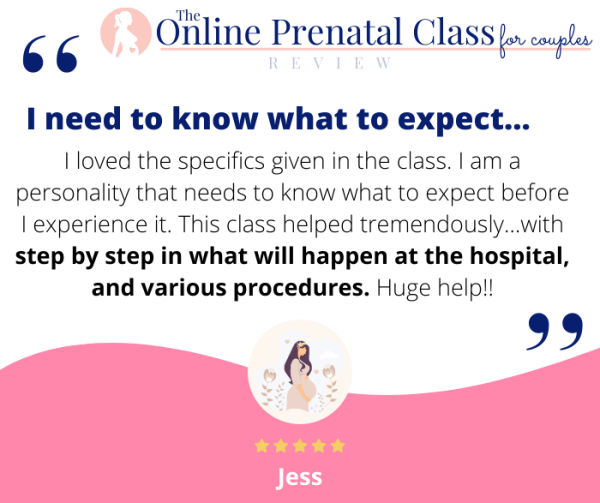I see it all the time — “I don’t think I’ll make it to my due date” — but is that correct OR the best way to think? Today I’m going to review the studies, and what I’ve seen in my time as a labor nurse.
Also, is thinking you’ll go early a good way to THINK? Let’s talk about it.
Before we get started, if you’re in that last month or two of pregnancy make SURE you’re not this person:
Your Provider Thinks You’ll Go Early
Let’s get this out of the way. Often, your provider might check you at 36 weeks and just say think “think it will be any day now.”
I have no idea why they say this. Other than the fact that it will likely be in the next month.
Even if your cervix is dilated (unless you’re like 5+ cm), even if you’ve lost your mucus plug, even if your baby is low — that doesn’t always mean labor is close.
There are two options at that point: Your body stays the same, or you go into labor — and there really is no way to guess who’s going to do which. That option happens every minute, of every day — and I get THAT uncertainty is hard.
Personally, I like to keep my mouth shut on stuff like this. I have FAR too often thought someone was in early labor and their cervix was so early labor — only to see them stay pregnant for another couple of weeks.
There just isn’t a real way to say what’s going to happen!
Also, your provider wants you to be done and stop being miserable almost as much as you do.
They also often want to brush-off questions about how to fix your pain rather than addressing it — but saying things like “well, you won’t be pregnant much longer” — when in reality they should say — how about a referal to PT to see if we can keep you a bit more comfortable this last month.
Are you sensing a soap box here? Because I am. 🙂
Don’t let your provider brush off your pain by saying “you’ll probably have this baby any day” when it could be addressed and you likely have another few weeks of being pregnant.
Here are a few posts on how providers can address common pains:
- Round Ligament Pain
- What To Do If You’re Miserable At The End Of Your Pregnancy
- 6 Easy Ways To Get Relief From Hip Pain During Pregnancy
- Can You Request To Induce Labor At 37 Weeks?
- Pain Between Your Legs During Pregnancy
And, don’t forget to make your birth plan:
What do the studies show on due dates?
I’ve been wondering for a while what the studies show about how long, on average people are pregnant (especially in the US where most of my readers are from):
According to this review — the average time of delivering the US as of 2020 was 38.5 weeks. That is compared to in 1990 when we didn’t induce much at all — the average gestational age at delivery was 39.1 weeks. When compared to home births (where they don’t have medical inductions, although some midwives will use a midwives brew) the average age was 39.5
Interesting, when they shifted the study to ONLY full term (37+ weeks) births it shifted with 40% (the majority) of births happening at 40 weeks.
Mindset tip: You really are aiming to go “full term” (aka 37+ weeks). Studies have shown those babies adjust better to life outside the womb and it is our goal as your healthcare team.
Things I learn from this:
Babies are being born, on average about a full week earlier than they used to be. I would guess this is from higher risk issues, and an a low-risk tolerance where we induce people frequently prior to term (and sometimes prior to 37 weeks).
When we look at babies JUST coming after 37 weeks, the average is still 40 weeks.
We USED to say that full term was 36 weeks, but we now call babies born from 34-36 weeks “late preterm” and while they usually do alright, they can have serious problems — so we REALLY try to avoid it if possible.
In this report we see that only 57% of babies make it full term, and that number is slowly decreasing.
I would like to find a study that only includes spontaneous labor but I couldn’t find one…. maybe I will find one at some point!
BUT, if you’re thinking due dates — grab my hospital packing list:
A Note on Due Dates
The came up with 40 weeks because that is the average time that people were pregnant starting from their last menstrual period. This is before birth starting getting super medical.
When you compare hospital vs home births — hospital births peak at 39 weeks, and home births peak at 40 weeks.
It’s important to remember that home births should only be low risk — meaning people with severe illness, or other complications — should NOT be delivering at home (and a good midwife will tell them this). So, that whittles it down to low-risk pregnancies (with no chance of a hospital induction).
When will you have your baby?
Most likely around 40 weeks, unless you are induced earlier.
If you don’t want to be induced, you’re likely going to go closer to 40 weeks. That’s when natural labor most often happens.
But we have NO IDEA what will happen in YOUR case. Will you have your baby early or late? We have no idea, until it happens. So far there’s nothing that can really predict when you’ll go into labor — but I do know one thing.
You need to plan on it being 40 weeks.
When you think it will be like 37 weeks you’re just not doing yourself any favors. Every day after 37 weeks is “extra” — which just isn’t the case.
Of course, watch for signs/symptoms of labor early on, but past about 37 weeks your thoughts should turn to comfort rather than “how can I get this baby out” because the studies also have shown there really aren’t too many reliable ways to get them out NOW (other than the medications used in the hospital for inductions).
How can I get this baby out early?
It’s probably my #1 question. A few facts for you:
- Where there are some studies that show things like dates or sex when done frequently over your last month of pregnancy can decrease your chance of an induction, it does NOT show that doing these things will put you into labor.
- The better question is how can I get more comfortable while I’m pregnant?
I have a whole category of posts called pregnancy pains that might give you some ideas!
I think some people put EXTRA pressure (and pain) on themselves — sometimes doing things like Jumping Jacks — when lowering their expectations and just chilling out would be their best plan of attack.
Another interesting note:
I found this part interesting….
This study showed Induction of labor after 37 weeks does reduce stillbirths. It also showed this:
Induction of labour probably made no or little difference for neonatal trauma, postpartum haemorrhage and breastfeeding compared with expectant management
Read the Cochrane review here
The consensus is still to wait until 39 weeks to choose an elective induction (no medical reason) but this is why providers, when a problem is noted, will pretty easily induce after 37 weeks.
Final thoughts:
You may go early, you may go late. One or the other might happen. We do know that ACOG is on board with elective inductions at 39 weeks — so you can always ask your provider about that, but other than that — we just don’t know.
So, plan on 40+ — it helps keep expectations low and you functioning longer. AND look for ways to days more comfortable as you’re growing a human in you. It truly is miserable and there’s no two bits about that. You’re doing great!
One of the worst parts can be wondering what birth will be like (and just wanting to get it over with).
The Online Prenatal Class for Couples is going to give you a play-by-play plan to know what birth will be like, how to make good choices, and prepared for life after baby is born too!
And, if you’re not quite sure you’re ready for that whole thing, check out my free insider tips to labor like a pro. It’s your first step toward getting in the driver’s seat of your birth.
Sources:
Declercq E, Wolterink A, Rowe R, de Jonge A, De Vries R, Nieuwenhuijze M, Verhoeven C, Shah N. The natural pattern of birth timing and gestational age in the U.S. compared to England, and the Netherlands. PLoS One. 2023 Jan 18;18(1):e0278856. doi: 10.1371/journal.pone.0278856. PMID: 36652413; PMCID: PMC9847908.
National Vital Statistics Report: Shifts in the Distribution of Births by Gestational Age: United States, 2014–2022
Middleton P, Shepherd E, Morris J, Crowther CA, Gomersall JC. Induction of labour at or beyond 37 weeks’ gestation. Cochrane Database Syst Rev. 2020 Jul 15;7(7):CD004945. doi: 10.1002/14651858.CD004945.pub5. PMID: 32666584; PMCID: PMC7389871.












 Postpartum Essentials for a Great Recovery
Postpartum Essentials for a Great Recovery
